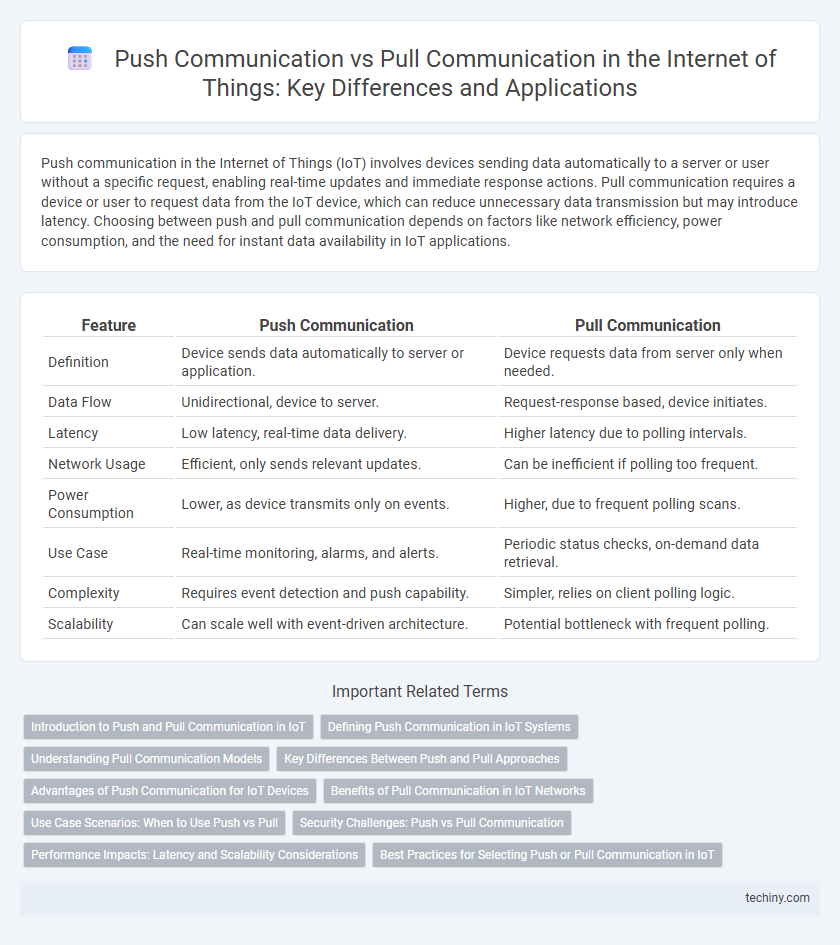Push communication in the Internet of Things (IoT) involves devices sending data automatically to a server or user without a specific request, enabling real-time updates and immediate response actions. Pull communication requires a device or user to request data from the IoT device, which can reduce unnecessary data transmission but may introduce latency. Choosing between push and pull communication depends on factors like network efficiency, power consumption, and the need for instant data availability in IoT applications.
Table of Comparison
| Feature | Push Communication | Pull Communication |
|---|---|---|
| Definition | Device sends data automatically to server or application. | Device requests data from server only when needed. |
| Data Flow | Unidirectional, device to server. | Request-response based, device initiates. |
| Latency | Low latency, real-time data delivery. | Higher latency due to polling intervals. |
| Network Usage | Efficient, only sends relevant updates. | Can be inefficient if polling too frequent. |
| Power Consumption | Lower, as device transmits only on events. | Higher, due to frequent polling scans. |
| Use Case | Real-time monitoring, alarms, and alerts. | Periodic status checks, on-demand data retrieval. |
| Complexity | Requires event detection and push capability. | Simpler, relies on client polling logic. |
| Scalability | Can scale well with event-driven architecture. | Potential bottleneck with frequent polling. |
Introduction to Push and Pull Communication in IoT
Push communication in IoT refers to devices sending data automatically to a server or application without a request, enabling real-time updates and immediate alerts. Pull communication involves devices waiting for a request from a server or user before transmitting data, allowing for on-demand information retrieval and reduced network traffic. Understanding the balance between push and pull methods is essential for optimizing IoT network efficiency and responsiveness.
Defining Push Communication in IoT Systems
Push communication in IoT systems refers to a data transmission method where devices or sensors proactively send information to a server or central system without waiting for a request. This approach enables real-time updates, efficient event-driven alerts, and continuous monitoring, crucial for applications like smart home automation and industrial IoT. Push communication reduces latency and enhances responsiveness by automatically transmitting data as soon as it's generated.
Understanding Pull Communication Models
Pull communication models in the Internet of Things (IoT) require devices or applications to request data from sensors or servers on-demand, ensuring real-time retrieval of specific information. This approach reduces unnecessary data transmission and conserves bandwidth by sending data only when explicitly requested, enhancing network efficiency. Pull communication is ideal for scenarios where data needs are intermittent or user-driven, enabling targeted and optimized data access within IoT ecosystems.
Key Differences Between Push and Pull Approaches
Push communication in the Internet of Things (IoT) involves devices proactively sending data to a server or endpoint without waiting for a request, ensuring real-time updates and reduced latency. In contrast, pull communication requires devices or applications to request data from sensors or other devices, which can introduce delays but conserves bandwidth and device power. Key differences lie in data delivery timing, network resource utilization, and suitability for various IoT applications, with push favored for critical, time-sensitive data and pull preferred for on-demand information retrieval.
Advantages of Push Communication for IoT Devices
Push communication enhances IoT devices' efficiency by enabling real-time data transmission, reducing latency in critical applications like smart healthcare and industrial automation. This method conserves device energy by eliminating the need for constant polling, extending battery life in remote or resource-constrained environments. Push communication also improves network scalability and minimizes bandwidth usage by sending updates only when events occur, optimizing overall IoT system performance.
Benefits of Pull Communication in IoT Networks
Pull communication in IoT networks enhances device autonomy by allowing sensors and actuators to request data only when needed, reducing unnecessary data transmission and conserving network bandwidth. This method improves power efficiency, extending the battery life of IoT devices by minimizing constant communication. Pull communication also increases system responsiveness by enabling devices to obtain real-time information precisely when required, optimizing resource allocation and network performance.
Use Case Scenarios: When to Use Push vs Pull
Push communication in IoT is ideal for real-time alerts and critical notifications, such as emergency sensor triggers or security breaches, where immediate action is required. Pull communication suits scenarios needing periodic data retrieval or on-demand information, like remote diagnostics or status checks in smart meters. Selecting between push and pull depends on latency sensitivity, data transmission frequency, and network resource constraints in the given IoT application.
Security Challenges: Push vs Pull Communication
Push communication in Internet of Things (IoT) devices often exposes systems to security risks such as unauthorized data injection and denial-of-service attacks due to its unsolicited data transmission nature. Pull communication enhances security by allowing IoT devices to request data only when needed, reducing the attack surface and mitigating risks like data interception and spoofing. However, pull mechanisms may introduce latency and require robust authentication protocols to prevent unauthorized data access and ensure secure device communication.
Performance Impacts: Latency and Scalability Considerations
Push communication in IoT reduces latency by delivering real-time data directly to devices, enhancing responsiveness for time-sensitive applications. Pull communication can introduce higher latency due to periodic data requests, potentially impacting real-time performance, but it offers improved scalability by allowing devices to manage data retrieval based on demand. Efficient IoT systems balance push and pull mechanisms to optimize network load, minimize latency, and support scalable device management across diverse environments.
Best Practices for Selecting Push or Pull Communication in IoT
Selecting push or pull communication in IoT depends on device capabilities, network conditions, and application requirements. Push communication is ideal for real-time data updates and low-latency scenarios, whereas pull communication suits periodic data retrieval and bandwidth-constrained environments. Best practices involve analyzing power consumption, data criticality, and security protocols to optimize performance and reliability in IoT deployments.
Push communication vs Pull communication Infographic

 techiny.com
techiny.com